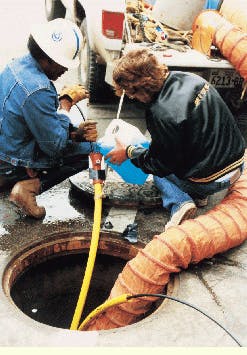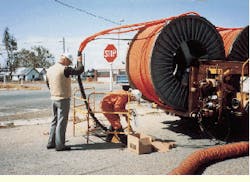Lynn Haber
Insurance is financial protection against disaster and usually proves to be expensive. This is not the case with cable lubricants, however; manufacturers of these products say they offer cabling installers the least-expensive insurance policy around. Lubricants buy protection for three of the most important elements of a cabling installation: the cable itself, the conduit and the cost of installation.
Cable lubricants minimize friction and stress as cable is pulled through a conduit. They reduce the risk of melted plastic, stickiness in the conduit and a pull that must be redone. "For $100 spent on lubricants, an installer can potentially save tens of thousands of dollars on cable," says Donald E. Larson, national sales manager at American Polywater Corp. (Stillwater, MN).
Cable lubricants have been around for decades. First used by the electrical industry, they have evolved to better suit the conditions and requirements of pulling copper, coaxial and optical-fiber cables for telecommunications and data communications applications.
The original cable lubricants were clays and talcum powder. From there, electricians moved to wax- and soap-based products. While still in use by electricians, these types of products are not suitable for installers working in the communications area because these lubricants are harmful to the cable jackets, causing unwanted deterioration. This has led to the introduction of polymer-based lubricants, which are essentially water-based and designed not to harm the cable jacket.
Most recently, manufacturers of cable-lubrication products have turned their attention to the special requirements of optical-fiber cable, leading to the introduction in the late 1980s of silicon-based lubricant products.
Before the introduction of these polymer-based gels, installers did the best they could with existing materials. "We used this yellow, viscous stuff, which was very messy to work with and tacky when it dried out," says Sam Parthemer, project engineer at Datalink Solutions Inc. (San Diego, CA). Today, he uses Aquagel, a polymer-based lubricant from Ideal Industries Inc. (Sycamore, IL). "This product is easy to use and simple to dispense," he says.
There are only a few major manufacturers of cable lubricants--American Polywater, Arnco Corp. (Elyria, OH) and Ideal Industries. Their product lines include more than a dozen varieties that meet different application requirements. You must know the type of cable pull and properties of the lubricant to match the most suitable product to the job.
According to Ronald Petersen, senior product development chemist at Ideal, installers need to consider five main lubricant properties and issues: compatibility, safety, lubricity, adherence and stability. For example, it is important to choose a cable lubricant that is compatible with the cable materials, he advises. There are some specialized cable jacket materials, particularly low-density polyethylene and semiconducting insulations, that may be damaged if the wrong lubricant is used. "Installers can damage the wire or conduit if they use an incompatible lubricant," he adds.
Petersen also makes the following points:
Lubricants designed for use with electrical wire should not be used for telecommunications and data communications applications. If, for example, an oil- or wax-based emulsion is used on low-density polyethylene, it can cause the cable to swell. If the cable is then pulled around a bend, stress-cracking can occur.
Make sure cable lubricants contain no harmful ingredients and are safe to handle. They should contain no chemicals that irritate the skin. Also, find out if they are odorless. They should be inflammable.
How well does the product lubricate? In other words, how slippery is it? Lubricity is defined by what is known as the coefficient of friction. The lower the coefficient, the less resistance there is during the cable pull and the easier it is to do the job. Look for a low coefficient of friction.
Lubricants can be thick or thin. They are available as pastes, gels and pourable gels. Installers sometimes determine viscosity based on the characteristics of the cable pull and sometimes they select lubricants by personal preference.
One property of a lubricant affected by viscosity is adherence, or how well the cable lubricant clings to the cable. How well it coats the conduit during a pull is also important.
You should consider product stability, or the lubricant`s tendency to break down or deteriorate over time. Sometimes this characteristic is referred to as lubrication residue. Soap- or waxed-based lubricants, for example, will dry to form a hard mass, making re-entry into a conduit difficult once the lubricant has set. Cable removal will also be difficult if there is no residue of lubricant.
Products have improved
Lubricant manufacturers have continually improved their products, with the biggest advances coming in the areas of lubricity and residue.
"We look for a product that stays soft after you`ve finished the pull and won`t damage the cable jacket," says Philip Baker, network engineer at Network Solutions Inc. (Tulsa, OK). Baker says that he has been using products from American Polywater for five years.
For copper and coaxial-cable pulls, polymer-based products are recommended. "They`re slippery and inert, so they won`t hurt the cable jacket," says American Polywater`s Larson.
Lightweight optical-fiber cable, on the other hand, requires a different type of lubricant. Because of its weight, this cable tends to bounce inside the conduit when it is pulled. Therefore, it needs a lubricant that will stay on the cable. Furthermore, because optical fiber is used in long runs, lubricants need to remain liquid. "You want a slippery residue," Larson adds.
The choice of product viscosity for a cable pull depends on environmental and working conditions. Liquids, for example, tend to be runny. This feature might be acceptable in an underground application, but not in an overhead cabling run inside a building.
Stringy gels are more difficult to work with than nonstringy gels, but they provide better performance, according to manufacturers. In fact, stringy gels are recommended for a difficult pull or for optical-fiber applications.
Lubricants modified with silicon give the best performance when it comes to friction reduction. "These products are mostly water-based, and they evaporate when cooled. They are also safe," says Jonathan Cahill, product manager at Arnco. However, they can also cause stress-cracking if misapplied.
Some product manufacturers offer silicon-based products that contain ball bearings. The theory behind this product is that the ball bearings facilitate the pull by allowing the gel to glide over the cable. However, industry experts apparently have mixed feelings about this type of product: some manufacturers offer it to those who want it, while others will not even carry it. "We don`t believe in using ball bearings because they dig into the cable jacket, causing scoring or pitting," says Cahill.
Applying lubricants can be a messy process. Installers have options in this area, however. They can apply lubricants by hand or pour them directly into the conduit or onto the cable. Some manufacturers also make products to help installers apply lubricants. American Polywater, for example, offers the Lubemaster, which is a gravity-fed device that applies the lubrication, cleans the cable during the pull, and requires no pumps or pneumatics.
Pumps are also available to help apply lubricants, particularly for long-haul projects where large amounts of lubricant are used. Pumps are impractical for smaller, inside jobs, however.
"Pourable lubricants are easily applied, and cling for the long haul, particularly for fiber-optic cable," says Arnco`s Cahill. In fact, liquids are usually used for fiber applications and are polymer- or silicon-based. "You don`t want to have to overcome viscosity drag associated with thicker lubricants," he adds.
Lighter lubricants are recommended for newer air-blowing methods for optical fiber. A small amount of lubricant should coat the inside of the conduit in these applications. Silicon-based lubricants, without the ball bearings, are also used for these applications. Polymer- or silicon-based gels are generally used with copper cable because they work better where there is high sidewall pressure.
Another factor that must be taken into account is the cable-pulling tension that is permitted for the cable being used. "We recommend that installers calculate the cable-pulling tension before doing a pull," says Larson. American Polywater facilitates this calculation by offering a software package. The company recently enhanced its Puller Planner software product to include a section for calculating fiber-optic pulling tension, adding this capability to existing calculations for other cable types.
While cable lubricants have changed over the years, pricing has remained fairly stable, with an annual increase of 2% averaged over a decade, according to industry players. Today, a gallon of high-grade liquid or gel cable lubricant can cost $8 to $10. Silicon-based products run considerably higher--almost two-and-a-half times the price of polymer-based products.
Is silicon worth the higher price? "You gain a 10% improvement in the coefficient of friction using silicon-based products," says Larson. "We let the customer decide."
Lubricant grades
Lubricants are available in a number of grades. For example, American Polywater offers eight different grades of gel lubricants and five grades of polymer-based products. Prices vary according to grade, so expect to pay a few dollars more for a better grade of lubricant. There is also a 25% cost premium on winter-grade products.
"Lubricants are definitely a low-cost, expendable item," says Parthemer of Datalink Solutions. But let the buyer beware: Even if the cost is low, there is no industry standard for product grading of cable lubricants. Grading systems of different manufacturers vary widely. "Buyers usually get that what they pay for," adds Cahill.
The variety of products and vendors keeps selection from being an issue. Installers are able to shop around for the products they want, but there is still room for improvement. "What I`d really like to see is a single lubricant type that works with multiple cable types," says Baker.
Products are available in 1-, 2.5-, 5- and 55-gallon containers, with each gallon weighing approximately 8.5 pounds.
Manufacturers say that knowing how much product to purchase for a particular application isn`t an exact science. "Measuring is usually done in the field, and there are times when all the conditions can`t be accounted for ahead of time," says American Polywater`s Larson. Nevertheless, the company provides customers with a formula to help calculate how much lubricant they might need:
length of pull in feet x diameter of conduit in inches x 0.002.
Lubricants have a long shelf life. Under rare circumstances, some products can deteriorate on the shelf if water purification is not done correctly. In such cases, separation can occur or bacteria can develop. "The product will probably still work, but it might not look as pretty," says Larson.
Cable lubricants are a low-cost, high-priority item for cabling installers. Manufacturers are quick to offer product information and advice to help them find the correct product for a particular application. Still, manufacturers admit that there is room for improvement. "I`d say that costs can still come down, and we still need to find a way to decrease stress-cracking," says Arnco`s Cahill.
Lynn Haber is a Norwell, MA-based freelance writer specializing in communications and computing.
In an outside plant application, cable lubricant is being poured into a lube collar and funnel device, which has been attached to innerduct. Fiber-optic cable is being pulled concurrently. (Photo courtesy of the Arnco Corp.)
a front-end bagging system developed by American Polywater Corp. eases the installation of innerduct into conduit. The bag system is also used to pull copper cables.


